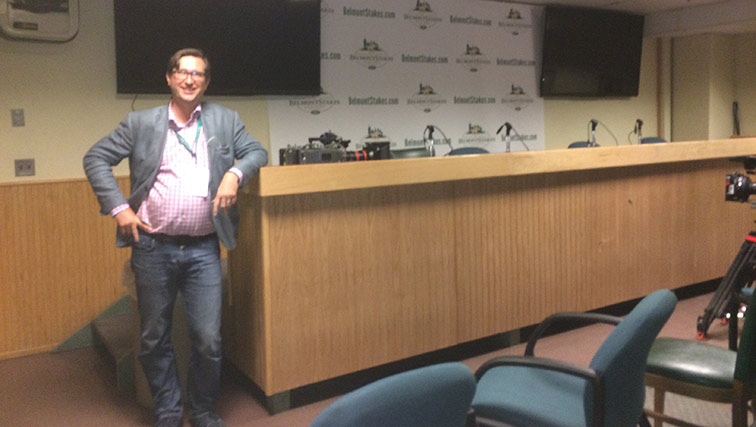Exploring Belmont’s Basement

Basements can be fun to explore. In many places, they can resemble a gigantic junk drawer. A motley collection of what-nots, essentials, things too big to store elsewhere and stuff that doesn’t fit anywhere else. When I had the opportunity to visit Belmont Park’s basement with the NTRA’s Jim Mulvihill, I immediately said yes. I didn’t know what to expect but I was sure looking forward it.
We walked through the tunnel and entered through the stairwell that goes downstairs to the jockey’s quarters. On the stairwell is a wonderful stylistic depiction of the paddock featuring a jockey mounting a Thoroughbred in front of the Belmont Japanese white pine tree. The painting reads, “You’re a Thoroughbred and today you’re going to race in New York. All that breeding, all that training helped make you fast enough to run in beautiful Belmont Park. And those people relaxing in the stands are here to watch you run. Good Luck.” Linoleum floors and institutional lighting lead the way to a series of rooms for the jockeys. There is a small cafeteria, the silks room and the jockey’s quarters.
Walking down the hallway, there are various set pieces used to decorate the Belmont stage where they make presentations and concerts. I saw some of the pieces moved earlier in the day and had actually wondered where they were going to store them. There are also old wooden desks and a series of fascinating wood carts that might have held programs at one time. They have lots of character and appear well worn. They are the kind of item that you stop at stare at when at an antique store on a weekend visit while thinking, “I wonder that they were used for?”
We end up in a warehouse that has several locked cages filled with what appears to have been race-day giveaways, cardboard boxes and signs. Lots and lots of signs. One corner of the warehouse is in high activity with workers preparing various signage for the weekend. Above them is a sign from a horse event in the 1980s. There are additional locked cages with possibly high-value items (cable, etc.). Staring inside the locked cages can ignite the quest to explore. I really longed to root around inside and see what treasures might be found inside the various boxes. There is that old adage that “one man’s junk is another man’s treasure!” Indeed! Perhaps there are old programs of historic races tucked away underneath a wooden shelf. Maybe there are old horse racing pictures in frames similar to some of the vintage art tucked around the track.
An interesting feature is the road that stretches the entire length of the grandstand. You can stand and see the sun shining at the end. It gives you a perspective as to how long the grandstand actually is. More importantly, it gives you a tremendous perspective as to the length of the stretch. It’s a long way from one end to the other.
After visiting the warehouse and storage area, we wandered down the halls. There are lots of various offices, mostly administrative. There is a first-aid station, but once we walked inside, it appeared to be much more. EMTs have stashed their response bags in one corner. There are several hospital-type beds and gurneys. We met a local icon who has worked at Belmont for the past 50 years. Nurse Doris Glier is 89 years old! It was an honor to meet here. She has many fond memories of the Belmont Stakes. Her face brightened when we talked to her about the jockeys she has known. She said that she especially remembers Pat Day, who retired in 2005.
I was fascinated with a print on the wall of the waiting-room area. Again, it featured the Belmont’s Japanese white pine. I am guessing that the print was from the 1940s. While one could easily make out the shape of the white pine tree, it was amazing to head upstairs later in the day to compare the drawing with the actual tree. I read on the Belmont’s website that the tree could be 175 years old. It hasn’t changed much throughout the years.
Next, we went to the theater where Jim Mulvihill will be the moderator of the post-race interviews on Saturday evening after the major races. It is a small theater seating 30 people, and it also has a small interview area. The interviews are piped into the press box for their convenience.
Too soon, it was time to head back upstairs for the rest of the race card. The workers in the warehouse were still painting signs. One wouldn’t realize all the hubbub going on underneath the grandstand. It’s all part of an orderly scheme to present a seamless day of entertainment for racetrack fans. It has everything but the kitchen sink, but I have a feeling if we went looking for one, we might find it! For a pack rat, it is the Triple Crown dream of storage space.
